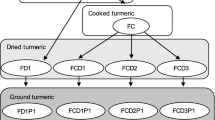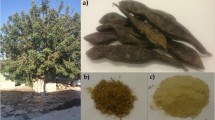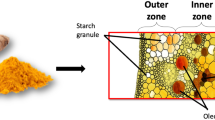Abstract
Effect of 4 independent variables — temperature (50–90°C), particle size (0.42–0.85 mm), mixing time (10–50 min) and solvent (ethanol) to meal ratio (10–50) on curcumin yield from turmeric (Curcuma longa L) was studied using central composite rotatable design. The experimental value of curcumin yield ranged between 4.49 and 12.89%. The second order model obtained for curcumin yield revealed a coefficient of determination (R2) of 0.78 and standard error of 0.72. The linear, square and interaction terms were significant at p <0.05 while lack of fit was non-significant at p >0.05. Surface graphs were plotted to optimize the curcumin extraction. The maximum curcumin yield was obtained when temperature, particle size, mixing time and solvent to meal ratio were 60°C, 0.42 mm, 30 min and 50, respectively.
Similar content being viewed by others
References
Anon (2007) Turmeric — The golden spice of life. www.turmeric.co.in (12/11/2008)
Cochran WG, Cox GW (1957) Experimental designs. John Wiley and Sons, Inc, New York
Cuong DH, Anh ND (2007) Investigations on the raw curcumin extraction from turmeric based on the alkalinization method. Hoa Hovac Ung Dung 9:42–44 (Abstract)
Goyal RK, Korla BN (1993) Changes in the quality of turmeric rhizomes during storage. J Food Sci Technol 30:362–364
Khanna N (1999) Turmeric-nature’s precious gift. Curr Sci 76: 1351–1356
Mandal V, Mohan Y, Hemalatha S (2007) Optimization of curcumin extraction by microwave assisted in-vitro plant bursting by orthogonal array designed extraction process and HPTLC analysis. Pharmacognosy Magazine 3(11):132–138
Rao DB, Sekhera NC, Satyanarayana MN, Srinivasan M (1970) Effect of curcumin on serum and liver cholesterol level in the rat. J Nutr 100:1307–1316
Srinivasan KR (1952) The colouring matter in turmeric. Curr Sci 21:311–313
Stankovic I (2004) Chemical and Technical Assessment. 61st Joint Expert Committee on Food Additives 1(8):1–8
Sun X, Gao C, Cao W, Yang X, Wang E (2002) Capillary electrophoresis with amperometric detection of curcumin in Chinese herbal medicine penetrated by solid-phase extraction. J Chromat A 962:117–125
Vijayakumar GR, Manohar B, Divakar S (2006) RSM to optimize amyloglucosidase-catalyzed synthesis of curcumin-bis-α-D-glucoside. Eur Food Res Technol 223:725–730
Author information
Authors and Affiliations
Corresponding author
Rights and permissions
About this article
Cite this article
Sogi, D.S., Sharma, S., Oberoi, D.P.S. et al. Effect of extraction parameters on curcumin yield from turmeric. J Food Sci Technol 47, 300–304 (2010). https://doi.org/10.1007/s13197-010-0047-8
Revised:
Accepted:
Published:
Issue Date:
DOI: https://doi.org/10.1007/s13197-010-0047-8




